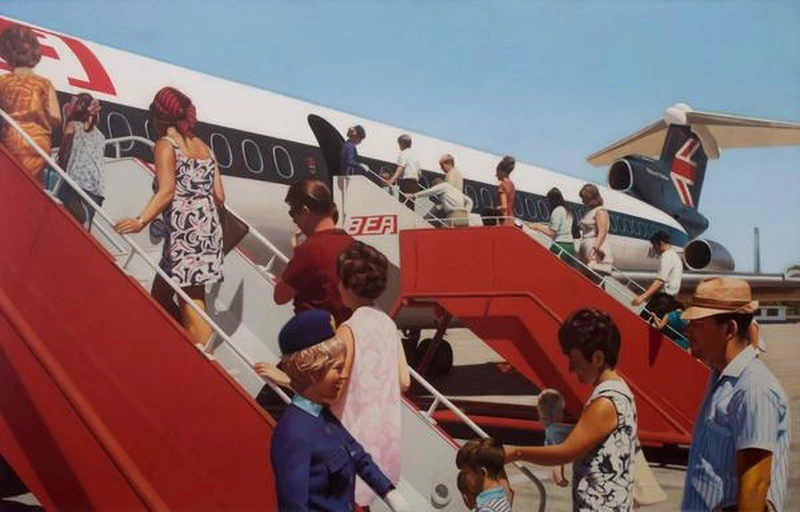Public Figure: Painting, Drawing and Photography
29 Nov 2022-17 Feb 2023


Austin / Desmond is pleased to present a selection of figurative works with a focus on three different mediums: painting, works on paper and photography.
Central to the exhibition is a (1971) painting by British photographic realist Harry Holland. In this highly stylized work, Holland perfectly captures a moment in time as holiday makers board an old BEA Trident, the uniform of the Flight attendant indicative of a style of travel that has long since vanished. Also included is a new work by painter Alexander Massouras from his ‘Four Summers’ series. Based on found images of recreation and tourism, sourced from old postcards and guidebooks, the painting depicts decontextualised figures in a blank landscape; the absence of detail acts as a direct prompt for the imagination, inviting the viewer to wonder where the figures are.
Incorporated into the show is ‘El Soldados’ (1967) by the Spanish artist Rafael Canogar. In the 1960s, as Franco’s regime integrated informalism as ‘official’ art, Canogar moved away from abstraction returning to figure painting. Inspired by a trip to the USA, he began to experiment with socio-political narratives focusing on human conflict. ‘El Soldados’ is from a series of works that looked at the effects war and violence had on everyday life. In it we can see the transition from soldier back to civilian, as war ends but chaos remains.
In the mid-1940s, inspired by the poetry of William Blake and the art of Samuel Palmer, John Craxton produced haunting landscapes, “somber pictures with moons and mysterious atmospheres". ‘Study for Reaper with a Mushroom’ (1944), is a pastel for one of Craxton’s most important paintings ‘Dark Landscape’ (1944-45) in the collection of Tate, London. The study embodies a particular era of Craxton’s work influenced by the Neo Romantics; a landscape that is somehow both open and claustrophobic.
Given prominent place is a 1996 etching by Lucian Freud. Performance artist and frequent muse, Leigh Bowery introduced Lucian Freud to unemployment officer Sue Tilly who became the subject for Woman with an Arm Tattoo. Freud’s initial intention was to paint her, but Tilly arrived sun tanned, a violation of Freud’s strict rules for posing. Instead, he made an etching that has become amongst his most recognisable. It is distinctive in that Freud frequently covered tattoos as he believed they distracted from the image but in this case he made an exception. It is a classic example of his fascination with flesh, the imperfections a representation of the human condition.
The exhibition features three works on paper by Christopher Wood. Two of the works are taken from a large group of drawings Wood made in 1926 for Serge Diaghilev’s production of Romeo & Juliet for the Ballet Russes in Paris. Whilst Max Ernst and Joan Miró were eventually selected for the project, Picasso commented that Wood’s designs “simply could not have been better or more beautiful.”
The lower gallery is dedicated to photography, featuring images from a self-performance by German photographer Jürgen Klauke. Viewed as an innovator of Performance Art, Klauke uses staged settings and surreal imagery to explore ideas of identity and paranoia. Alongside are other performance pieces by Katalin Ladik, a collotype by Richard Hamilton and a self-portrait by Robert Mapplethorpe.
Works by Eileen Agar, Vanessa Beecroft, Barbara Hepworth, Roger Hilton, David Hockney, David Jones, R.B. Kitaj, Julius Koller, Wyndham Lewis, Cedric Morris, C.R.W. Nevinson, Richard Pettibone and Keith Vaughan are also included.